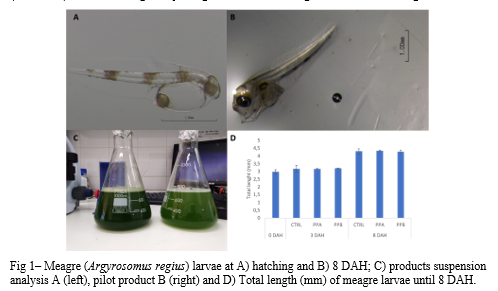NEW MICROALGAE FORMULATIONS FOR GREEN WATER TECHNIQUE: CASE STUDY OF MEAGRE Argyrosomus regius LARVAL REARING
Introduction
Microalgae are used in marine larval rearing in green water technique with synergistic effects beneficial for larvae. Marine fish show altricial larvae that hatch with immature organs such as eyes and gut essential to capture and digest preys. Microalgae in the water column applied through green water technique have beneficial effects in larvae since they allow the refraction of light and improve the observation of live prey, maintaining rotifers simultaneously enriched. Additionally, microalgae are known to vector beneficial probiotics that colonize larvae gut, improving environmental water quality, fish welfare and stress resistance. Industrially produced microalgae are a major asset in aquaculture, although still underused mainly due to the lack of specific product development and application protocols specifically adapted to the rearing systems. In marine larviculture the use of live microalgae produced within the facilities is still a common practice despite being labour intensive and prone to productivity fluctuations. There have been major advances in biotechnology improving the quality of microalgae biomass and increasing the number of microalgae strains available commercially. However, the application of this high-quality biomass in aquaculture presents some important challenges such as microalgae precipitation and stability in the water column, which may impair water quality. This disadvantage can be mitigated by the use of beneficial probionts through the modulation of the microbiota in the tank1. The application of probiotics as water conditioners has been thoroughly studied and it is a common practice in animal production, including aquaculture. The objective of this study was to develop new formulations for green water technique with industrially produced microalgae strains and probiotics using meagre (Argyrosomus regius) larval rearing as a case study.
Material and methods
The selection of microalgae strains and its typology was performed according to cellular dimensions, stability in water column and a technoeconomic study, after which Nannochloropsis sp. and Chlorella sp. spray dried were selected. Pilot product A (PPA) contained only microalgae and pilot product B (PPB) contained microalgae along with probiotic bacteria. An exploratory approach was performed to find adequate indicators of the formulation mixture quality to find mixing quality indicators adequate to the formulation. The hydration and the blending times were optimized with a set of tests. The colour of the blends was evaluated according to the RAL scale and the precipitation time was monitored after 24h in salt water. To investigate the effects of the selected conditions, an experimental design was set up with a control composed by live Nannochloropsis sp., a microalgae formulation and a formulation containing microalgae and probiotics. The experiment was performed in IPMA aquaculture research station (EPPO, Olhão) in open cylindroconical tanks (200L) in triplicate. Newly hatched larvae were introduced (43.25 larvae/L) with a water temperature of 21±1ºC, 37‰, a photoperiod of 10-14 D:L. Rotifers where introduced at mouth opening, artemia and microdiet (Caviar, Bernaqua®) where introduced at 10 days after hatching (DAH) (100-200µm) increasing the granulometry through development and fed Ad libitum. Environmental parameters were monitored (pH, salinity, oxygen, temperature, ammonia, nitrates). The microalgae present in the water column and its precipitation was monitored spectrophotometrically three times a week (1h, 2h and 3h after microalgae introduction). Larvae survival and growth was evaluated (n=15 per replica per time point) through total length and dry weight analysis. Microbiota was monitored in water and larvae (TSA, TCBS). A final stress challenge was applied in all treatments with a transport of 250 km. The environmental parameters were monitored (temperature, oxygen, pH, ammonia and nitrates), survival was evaluated on the arrival and 8 days afterwards.
Results and Discussion
The products revealed an adequate mixing rate of 3 min (129 rpm), being selected also an hydration time of 10 min followed by 5 min of blend. The mixture was sieved with a 50 µm mesh to remove the foam and microalgae agglomerates. The colour of the products according to RAL scale was for PPA 6028 and for PPB 6024. The quantities to be applied in the tanks were adjusted according to the turbidity measured with a probe (5±1 FTU). The microalgae dry weight in the tanks range from 0.01 to 0.04g/L.
Preliminary results showed similar growth of meagre larvae reared in green water with live microalgae or with formulated products. The combination of probiotics and microalgae allowed a higher stability of the microalgae in the water column compared with the product containing only microalgae. One hypothesis for this result is the generation of biosurfactant metabolites by the probiotics2 contributing for the reduction of surface tension. This work will allow to understand the effect of formulated microalgae and probiotic products for green water technique applied in meagre larviculture and its effects on larvae and water bacterial communities, larvae welfare and stress resistance.
References
1.Tarnecki, A. M., Wafapoor, M., Phillips, R. N. & Rhody, N. R. Benefits of a Bacillus probiotic to larval fish survival and transport stress resistance. Sci. Rep. 9, 1–11 (2019).
2.Al-Ajlani, M. M., Sheikh, M. A., Ahmad, Z. & Hasnain, S. Production of surfactin from Bacillus subtilis MZ-7 grown on pharmamedia commercial medium. Microb. Cell Fact. 6, 1–8 (2007).
Acknowledgements
Supported by Project Allarvae - 069971 supported by CRESC Algarve, Portugal 2020 and European Union
